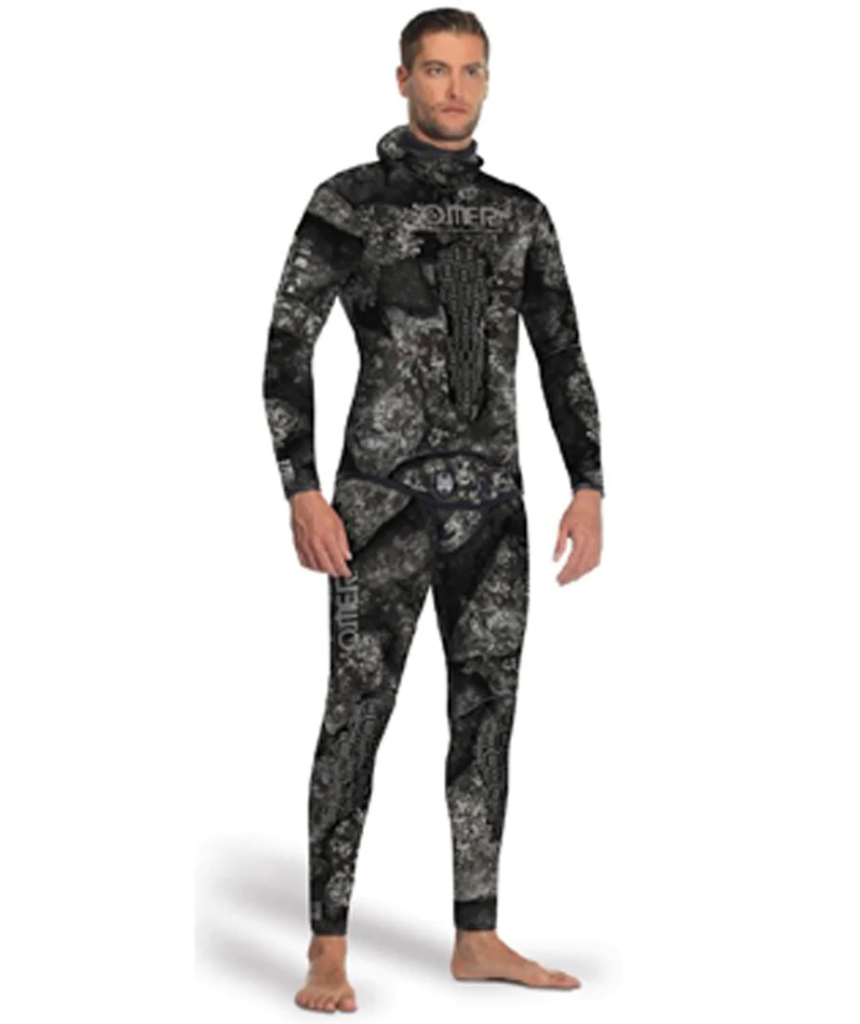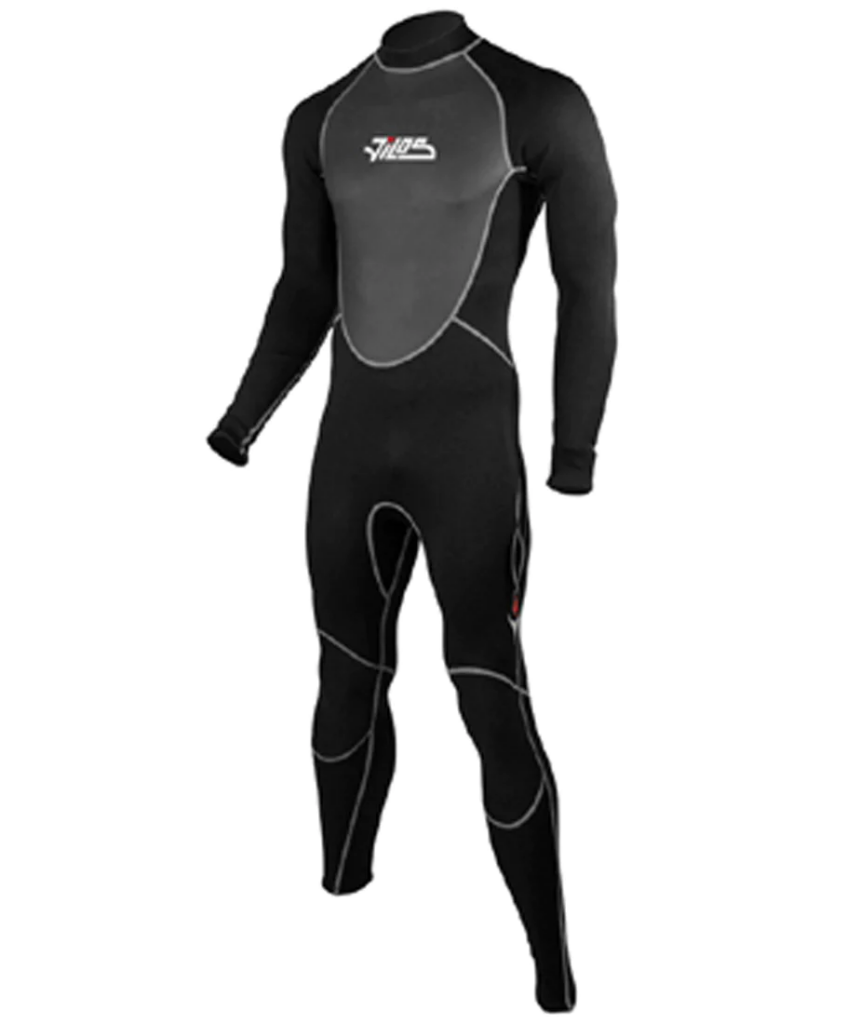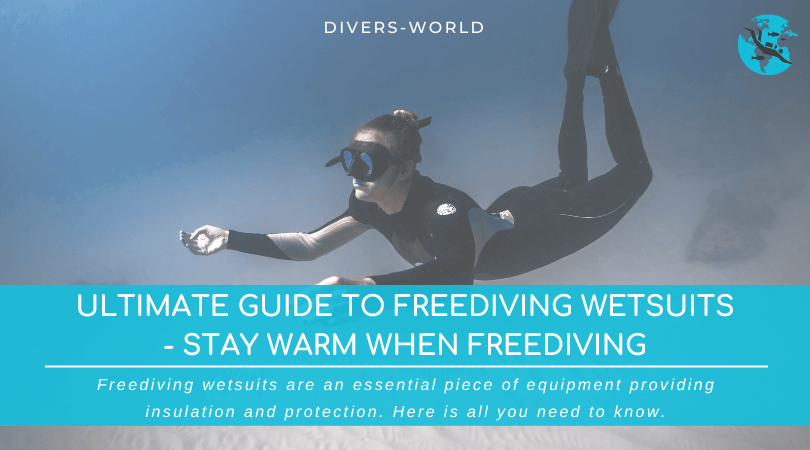While many new freedivers get caught up in a gear-buying frenzy, freediving wetsuits are an essential piece of equipment (and often one of the most neglected). A high-quality wetsuit will provide insulation and protection from the elements. Not only this, but a freediving wetsuit can also increase your streamlining ability in the water.
In this guide, we will discuss everything you need to know before buying a wetsuit for freediving. From freediving wetsuits vs. scuba wetsuits to picking the right style – we have you covered!
Table of Contents
Our Pick of Freediving Wetsuits
- Great single-lined open cell freediving wetsuit: Riffe DIGI-TEK Camouflage Freediving Wetsuit
- Great double-lined closed cell wetsuit: OMER Blackstone Camouflage Freediving Wetsuit
- Great smooth-skin wetsuit: Tilos Steamer Wetsuit with Smoothskin Chest
- Great sandwich wetsuit: Cressi Ricciola Wetsuit
Read on for more information and details on each product. Some of the product descriptions in this post may contain affiliate links.
Why Do People Wear Freediving Wetsuits?
If you have never tried freediving with a wetsuit, you may wonder why so many people wear one. After all, many freedivers love the freedom of diving with no gear. But the simple answer is that a wetsuit can make all the difference in terms of comfort and performance underwater.
Every experienced freediver understands the importance of freediving with a wetsuit on. Let’s look at some of the main benefits and help you understand why:
Insulation
It can get chilly underwater, especially during winter and in colder regions. To avoid low body temperature or hyperthermia, freediving with a wetsuit is essential to keep you warm. Having an insulated wetsuit can help you stay underwater for longer and may even reduce fatigue.
Sun Protection
A wetsuit can protect you from the sun’s harmful UV rays when freediving in a warm climate. This is especially important if you spend a lot of time in shallow waters. The sun can penetrate up to 1,000 meters below the water’s surface – so wearing a freediving wetsuit can help stop you from getting sunburnt.
Streamlining and Hydrodynamics
Freediving wetsuits are designed to be flexible and snug against your body, helping to reduce drag and improve your hydrodynamic profile. This will help you to move through the water with less effort, allowing you to conserve energy and stay underwater longer.
Injury Protection
Underwater hazards like sharp rocks and coral or marine life, such as jellyfish, can all cause painful injuries. A durable freediving wetsuit can provide extra protection against these underwater risks.
What Types of Wetsuits Are Available?
If you were to type ‘wetsuits’ into an online search engine, you’d be presented with mixed results. Many types of wetsuits are available on the market, but only some are suitable for freediving. To help you navigate the world of freediving wetsuits and beyond, let’s look at the main types of wetsuits available:
Rash Guards
Rash guards are popular for recreational freedivers as they provide a close fit without compromising flexibility. The protection from UV rays and abrasion is also a bonus. However, they don’t offer any significant insulation, making them best suited to warm water freediving. A specific freediving wetsuit is a better option for divers who take the sport a little more seriously.
Rash guards are a great option if you are primarily interested in skin diving – check out this guide.
Freediving Wetsuits
When freediving, you must choose a specific wetsuit for the sport. These wetsuits are usually made from neoprene, have a snug fit, and are incredibly flexible. This style of wetsuit rarely has a zip closure, as this can allow water to seep through. Freediving wetsuits also tend to be thinner than other types, yet are well insulated and come in two distinct styles: a one-piece or two-piece freediving wetsuit.
One-Piece Freediving Wetsuit
This wetsuit style covers the entire body, from the neckline to the ankles and wrists, and can come with a hood for added insulation. A one-piece freediving wetsuit may have a zip closure to the back, allowing water to trickle in – which is not ideal. This style is often the go-to choice for new freedivers but is not the preferred option for more experienced freedivers.
Two-Piece Freediving Wetsuit
A two-piece freediving wetsuit usually comes with high-waisted pants or a ‘farmer john’ style bottom and a jacket. This wetsuit style can also come with a hood and is often easier to get into than a one-piece. There is no need for zippers with a two-piece freediving wetsuit, which only adds to the suit’s flexibility. This style is generally the preferred choice for most freedivers and spearfishers.
Scuba Wetsuits
Scuba wetsuits are generally thicker than freediving wetsuits and offer decent insulation. However, they are less flexible. Scuba wetsuits also tend to include zippers, which can leak water – making for an uncomfortable freedive. There are several differences between freediving and scuba wetsuits, which are essential to note when making a purchase.
Surf Wetsuits
Surf wetsuits are more flexible than ones used for scuba diving but are still not suited for freediving. This wetsuit style often has zip closures and is much more buoyant than a freediving wetsuit. While this is great for helping surfers stay afloat, it could create an uncomfortable freedive for you.
Freediving Wetsuits vs. Scuba Wetsuits
Many new freedivers make the mistake of buying a scuba wetsuit for freediving, only to discover that it is not suitable. When comparing freediving wetsuits vs. scuba wetsuits, there is one main difference: nitrogen bubble size.
While a thicker wetsuit can help keep you warm, the nitrogen bubbles within the wetsuit’s neoprene material provide insulation. There are two commonly used types of neoprene: open cell and closed cell. While you can get scuba and freediving wetsuits made from closed cell, specialized freediving wetsuits are usually made from open cell neoprene.
Open cell neoprene wetsuits are thinner and often unlined, meaning the nitrogen air bubbles are less constricted and larger. This creates a warmer, more insulated, freediving wetsuit that is also highly flexible. Scuba wetsuits are thicker and usually lined, meaning the nitrogen air bubbles are smaller. This provides less insulation and mobility when compared to a freediving wetsuit.
With this in mind, let’s look at some more differences between freediving and scuba wetsuits:
Pressure
It is important to note that underwater pressure can affect the nitrogen bubble size in wetsuits, regardless of the type of neoprene used. The deeper you go underwater, the more the air bubbles compress and become smaller. This means that a scuba wetsuit may be warmer at depth – but a freediver will not be underwater long enough for this to be an issue.
Movement and Flexibility
Freediving wetsuits are designed with flexibility and ease of movement in mind. The aim for most freedivers is to dive as deep as possible on a single breath-hold. This means the freediving wetsuit must allow you to move freely and effortlessly.
A thicker scuba wetsuit is not designed for this purpose, so it can impede your movement and increase fatigue. And as scuba wetsuits are often thicker, this makes them more buoyant – which is not what you want when freediving.
Zippers and Entry Points
Scuba wetsuits often come with a zip closure, while most freediving wetsuits have no zipper. This is to minimize water entry and increase the efficiency of the suit. It also helps to reduce drag, making it easier to move through the water quickly. Many freediving wetsuits also come with hoods that help keep you warm and improve hydrodynamics.
Both scuba and freediving wetsuits work well for their intended purpose. But when it comes to freediving, you should always opt for a specialized freediving wetsuit. It is vital to select the correct type of wetsuit for the conditions you will be diving in and the depths you are trying to reach – this way, you can enjoy maximum comfort while underwater.
How to Choose a Freediving Wetsuit
A good wetsuit and make or break a freedive. After all, you don’t want your rigorous training to be hindered by the wrong type of suit!
Here are a few things to consider when choosing the right freediving wetsuit:
Flexibility
You know a scuba wetsuit is not appropriate for freediving due to the lack of flexibility. A wetsuit’s material composition, zippers used, and overall style will affect movement when diving. As such, ensure your suit provides maximum flexibility when selecting a freediving wetsuit.
Thickness
A specialized freediving wetsuit will already offer good insulation. But when freediving in colder waters, you may want to opt for a thicker wetsuit. While a thicker wetsuit can increase buoyancy and decrease some flexibility, no one wants to be cold while deep underwater.
As a general guide, here is what wetsuit thickness to choose based on water temperature:
- 82F> (28°C>): 2mm or less
- 75°-82°F (24-28°C): 3mm
- 64°-75°F (18-24°C): 5mm
- 60°-75°F< (16-18°C<): 7mm
Durability
The last thing you want is to have your wetsuit tear or rip when underwater. Some freediving wetsuits, such as smooth skin suits, will be more susceptible to tears and abrasions, but the benefits of such suits often outweigh the cons. With this in mind, you want to ensure your wetsuit is constructed well and is made of high-quality materials that will last through multiple compressions.
Size
The fit of your wetsuit is important. It should fit snugly but not so tight that it restricts your movement or breath hold ability. It should not be too long or short, and there should be no loose fabric that can cause drag in the water. If you see yourself freediving with a wetsuit often, you can have a custom-made wetsuit created to fit the contours of your body perfectly.
Diving Style
The type of freediving wetsuit a professional athlete chooses to wear may not fit the needs of a recreational freediver. Be sure to consider your diving style before purchasing a wetsuit. Are you looking for a suit specifically designed for open water competitions, or would you prefer one made more for leisurely dives?
The Different Freediving Wetsuit Materials
Almost all freediving wetsuits are crafted from neoprene. Neoprene is a completely waterproof material with rubber-like properties that is both lightweight and durable. Depending on the particular wetsuit, neoprene can be lined with other materials and comes in varying thicknesses.
Here we have compiled a brief overview, with examples, of the main types of freediving wetsuits – so you can make an informed decision before buying.
Single-Lined Open Cell Wetsuits
Single-lined open cell wetsuits only have a lining on the outside of the wetsuit. This means that the neoprene is in direct contact with your skin – providing excellent insulation capabilities. The outer lining of an open cell wet suit adds durability without restricting movement. But as the inside of an open cell wetsuit is unlined, it can prove tricky to put on. You must either lubricate your skin (with a marine-safe product) or wet the wetsuit when suiting up.
Riffe DIGI-TEK Camouflage Freediving Wetsuit
Price: From $380

The Riffe DIGI-TEK Camouflage Freediving Wetsuit is the perfect choice for a single-lined freediving wetsuit. Made from Yamamoto Neoprene, renowned for being the best neoprene in the world, it guarantees professional-grade performance when freediving and spearfishing.
On top of this, its outside layer offers terrific stretch and additional features such as a hood, glue and blind stitched seams, and knee and chest pads – all coming together to add unprecedented comfort and protection. The wetsuit is available in various thicknesses.
Double-Lined Closed Cell Wetsuits
A double-lined closed cell wetsuit is lined, usually with nylon, inside and outside the suit. This lining adds extra durability and helps make it easier to put on and take off. Double-lined wetsuits are less stretchy due to the nylon, but they provide the best protection from the elements. Although, if insulation is a priority, a single-lined open cell freediving wetsuit is your best option.
OMER Blackstone Camouflage Freediving Wetsuit
Price: From $380

When it comes to comfort, the OMER Blackstone Camouflage Wetsuit is ideal. Made using high-quality neoprene, this two-part wetsuit comprises a hooded jacket and high-waist pants that provide a snug fit.
The extra-stretch nylon used guarantees an extreme comfort and flexibility level. The OMER Blackstone is nice and durable – just what you want from a freediving wetsuit.
Smooth Skin Wetsuits
Smooth skin wetsuits are constructed with a single layer of smooth neoprene and no nylon lining. This style of freediving wetsuit provides brilliant insulation, as well as being extremely hydrodynamic in the water. As such, smooth-skin suits are a popular choice amongst competitive freedivers. The downside is that they are more likely to tear or rip due to their lack of durability.
Tilos Steamer Wetsuit with Smoothskin Chest
Price: From $180

Made with the highest quality neoprene, the Tilos Steamer Wetsuit with Smoothskin chest is great for both spearfishing and freediving. It’s designed with an open cell interior for optimal insulation and a smooth skin exterior to allow for silent movement in the water.
Sandwich Wetsuits
A wetsuit made from a ‘sandwich’ of materials is not the usual choice for a casual freediver, but options are available. These wetsuits are usually constructed from nylon, with a layer of open cell neoprene inside and smooth skin outside. While much more durable than a standard smooth skin freediving wetsuit, they are often more expensive and are not as stretchy.
Cressi Ricciola Wetsuit
Price: From $350

The Cressi Ricciola Wetsuit is designed to keep you feeling comfortable and warm – while also allowing you to perform your best in the water. Made with open cell ‘sandwich’ neoprene, this wetsuit is highly resistant without sacrificing warmth or gliding properties.
With additional options, such as reinforced elbows and knees for maximum protection and durability, the Cressi Ricciola makes an awesome freediving wetsuit.
Freediving Wetsuit Stitching
You want to find a freediving wetsuit that uses the glue and blind stitch technique. This process is where the seams are glued together before being stitched with ‘blind stitches.’ This not only provides better insulation than a regular stitched suit, but it is also much more durable and watertight.
How to Care For Your Freediving Wetsuit
Caring for your freediving wetsuit is essential if you want to maintain its quality and extend its lifespan. Some care tips we swear by are:
- Rinsing your wetsuit in fresh water after each use.
- After rinsing, allow your freediving wetsuit to air dry naturally.
- Store in a cool place away from direct sunlight.
- If your wetsuit becomes damaged, repair it immediately to avoid further damage. Neoprene cement and repair patches are available to help with this.
- Avoid folding or compressing your wetsuit.
Final Thoughts on Freediving Wetsuits
Choosing a wetsuit for freediving can be daunting. However, we hope this guide has helped you to make an informed decision! Remember to consider how you will use the wetsuit and what type of environment you most often dive in. Each type of freediving wetsuit has its advantages and disadvantages, so take your time to decide on one that is right for you.
Once you have started freediving with a wetsuit, make sure to properly care for your wetsuit to keep it looking and functioning like new. With the right wetsuit, you’ll be ready for any underwater adventure!

